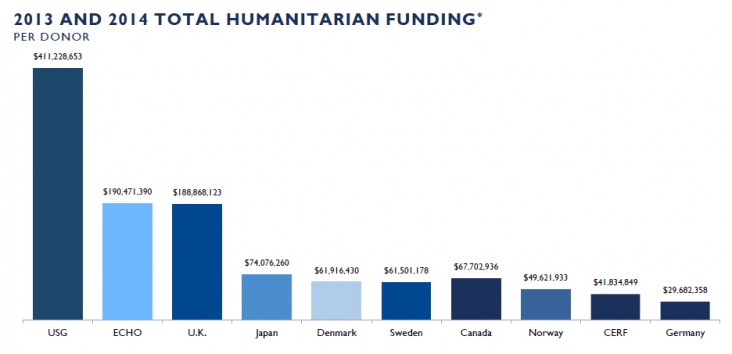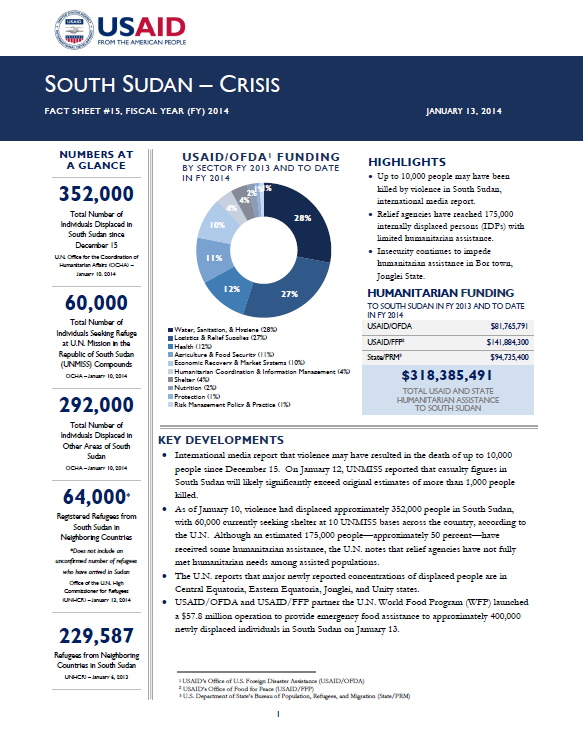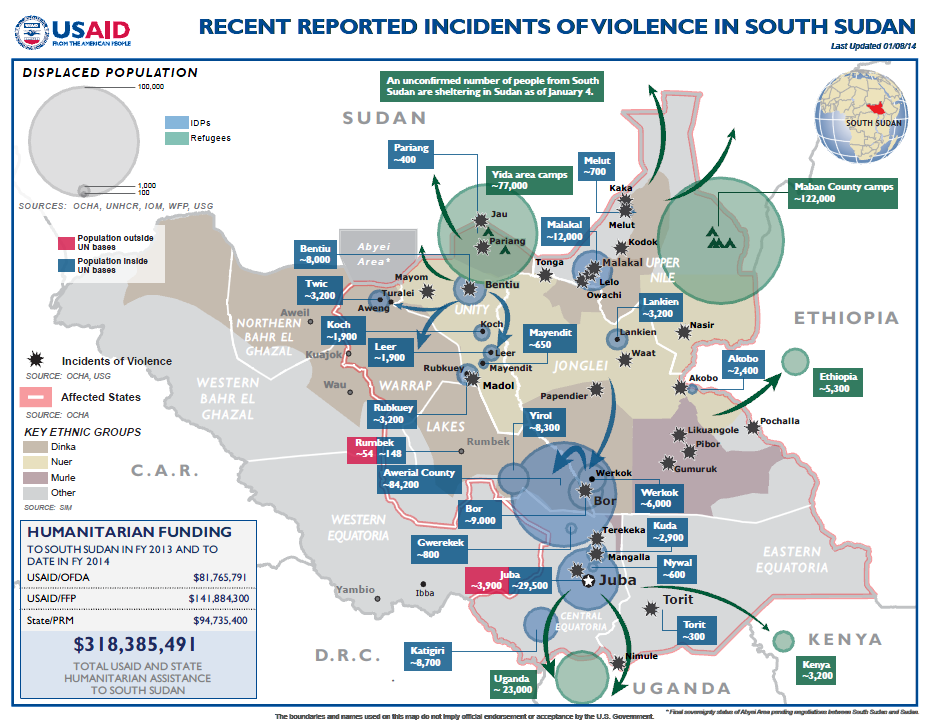- What We Do
- Agriculture and Food Security
- Democracy, Human Rights and Governance
- Economic Growth and Trade
- Education
- Environment and Global Climate Change
- Gender Equality and Women's Empowerment
- Global Health
- Humanitarian Assistance
- Transformation at USAID
- Water and Sanitation
- Working in Crises and Conflict
- U.S. Global Development Lab
Speeches Shim
January 31, 2014
Numbers At A Glance
739,700
80,100
659,600
123,400
230,200
Humanitarian Funding:
To South Sudan To Date In FY2013 and FY2014:
| USAID/OFDA | $86,383,207 |
| USAID/FFP | $141,884,300 |
| State/PRMDoD | $94,735,400 |
| TOTAL | $323,002,907 |
Highlights
Clashes continue in Jonglei, Lakes, and Unity states, with displacement increasing in Unity’s Leer and Koch counties.
Limited humanitarian assistance has reached more than 299,000 people since hostilities began on December 15.
Insecurity, looting, and widely dispersed populations present challenges to aid delivery.
KEY DEVELOPMENTS
Population displacement continues to increase as insecurity persists across South Sudan, with violence displacing more than 863,000 people—both internally and as refugees to neighboring countries—since December 15, according to the U.N. The majority of internally displaced persons (IDPs) are located in rural areas outside of UNMISS bases, with approximately 80,100 IDPs sheltering at UNMISS sites across the country.
Security conditions remain unpredictable in many conflict-affected areas throughout South Sudan. Hostilities and population displacement have significantly increased in central and southern areas of Unity in recent days, with violence displacing approximately 188,100 people statewide—representing a 59 percent increase in displacement since January 23.
Ongoing fighting has prompted humanitarian staff to evacuate from affected areas of Leer and Koch, preventing life-saving assistance from reaching communities in need. According to Médecins Sans Frontières, medical personnel and patients fled the hospital in Leer on January 31. The closure of the medical facility—the only functioning hospital in southern Unity—will likely limit access to health care for more than 270,000 people.
Despite the challenging operating environment facing humanitarian actors in conflict-affected areas, relatively stable conditions have enabled relief agencies to resume aid activities in Awerial County, Lakes, and expand operations in Bentiu town, Unity.
SITUATION, DISPLACEMENT, AND HUMANITARIAN NEEDS UPDATE
As of January 30, violence had internally displaced approximately 739,700 people in South Sudan, including 80,100 people currently seeking shelter at UNMISS bases, according to the U.N. Internally displaced populations have sought shelter in more than 100 locations countrywide, with nearly 20 sites hosting more than 10,000 people each. Countrywide, the highest concentration of displaced populations are located in Unity, with approximately 188,100 IDPs, and Upper Nile State, with an estimated 157,300 people.
Relief agencies remain gravely concerned by rapidly increasing population displacement and risks associated with overcrowding at IDP sites, such as deteriorating public health and water, sanitation, and hygiene (WASH) conditions and resultant disease outbreaks. In addition, conflict-induced displacement is generating increased protection concerns, including targeting of civilians, physical and sexual violence, targeted destruction of property, separation of families, and psychosocial trauma, according to the U.N.
While the security situation in the capital towns of Jonglei, Unity, and Upper Nile states remains relatively calm despite heightened tensions, clashes continue in central Unity and in rural areas near Jonglei’s Bor town and in Twic East County. Due to ongoing insecurity in central and southern Unity, humanitarian activities remain confined to Bentiu, while security conditions have improved in Upper Nile’s Malakal town. Despite limited security improvements in some areas of South Sudan, displaced populations remain unable to safely return to areas of origin.
Humanitarian access and looting continue to impede aid operations, with the U.N. World Food Program (WFP) reporting that armed actors and criminal elements have looted approximately 4,300 metric tons (MT) of food supplies—sufficient to support more than 257,000 people for one month—from WFP warehouses as of January 28.
Humanitarian organizations are collaborating with U.N. security personnel to improve security in UNMISS bases hosting IDPs. Violence and criminality within civilian protection areas in UNMISS compounds are reportedly increasing and impacting the ability of relief organizations to operate safely within civilian areas.
South Sudan Crisis Fact Sheet #23 January 31, 2014 ![]() (pdf - 381k)
(pdf - 381k)
South Sudan Crisis Map January 31, 2014 ![]() (pdf - 435k)
(pdf - 435k)
HUMANITARIAN RESPONSE ACTIVITIES
Although humanitarian organizations have reached approximately 299,300 people with humanitarian assistance since hostilities erupted on December 15, relief agencies have not fully met needs among assisted populations due to a lack of sustained, predictable access, according to the U.N.
With improved access to information related to humanitarian needs, relief organizations have used data on insecurity, displacement, food insecurity, and historical likelihood of flooding to identify and map populations that currently face acute needs and may become more vulnerable in the coming months. According to initial reports, Central Equatoria State’s Juba County, Jonglei’s Bor South County, and Unity’s Pariang and Rubkona counties represent the most vulnerable areas in South Sudan. Relief agencies will use mapping exercises to help prioritize areas for assessment and response.
Despite insecurity and access constraints, relief organizations have reached approximately 196,000 conflict-affected individuals with food assistance since December 22, including 63,900 people in Lakes; 32,600 people in Central Equatoria; 32,200 people in Upper Nile; 27,300 people in Jonglei; 23,200 in Unity; 8,800 people in Eastern Equatoria; and 6,700 people in Warrap; as well as additional populations in Western Bahr el Ghazal and Western Equatoria states.
Relief agencies are responding to acute health and nutrition needs by providing emergency medical assistance for wounded individuals, primary health care services, and large-scale vaccination campaigns. As of January 30, relief organizations had treated more than 4,800 people with gunshot wounds countrywide and provided medical consultations for nearly 4,900 individuals in the Awerial, Bentiu, Juba, and Malakal displacement sites, treating cases of respiratory tract infections, malaria, and diarrhea. To date, more than 54,900 children have benefitted from integrated vaccination campaigns—including polio and measles vaccinations, vitamin-A supplements, and deworming services—in IDP sites in Awerial, Bentiu, Bor, and Juba.
To support malnutrition detection and treatment efforts, health care workers have screened approximately 24,700 people for malnutrition and admitted acutely malnourished individuals, including children and pregnant and lactating women, for inpatient treatment. In coordination with U.N. and non-governmental organization (NGO) partners, WFP is planning blanket supplementary feeding programs for IDPs in rural areas to address nutrition concerns.
To help improve living conditions in crowded areas and ensure access to safe drinking water, relief agencies have reached nearly 208,000 people with WASH assistance since December 15.
USAID/OFDA partner the U.N. Humanitarian Air Service (UNHAS) continues to operate regular flights and address ad-hoc requests from the humanitarian community to provide airlift services to new locations as needs arise, improving crucial access to displaced and conflict-affected populations. To meet additional airlift requirements, the Logistics Cluster—the coordinating body for humanitarian logistics activities, comprising U.N. agencies, NGOs, and other stakeholders—has arranged additional charter flights to Jonglei, Lakes, Unity, and Upper Nile.
The International Organization for Migration (IOM) has launched an airlift operation to move urgently needed relief commodities to conflict-affected populations across South Sudan. Flights are originating from IOM’s logistics hub in Juba, carrying medicine, shelter materials, WASH supplies, and relief items—including blankets, buckets, kitchen sets, mosquito nets, and soap. Several flights have already delivered emergency relief supplies to the UNMISS base in Malakal, which is currently sheltering nearly 28,000 IDPs. The airlift operation will continue through the following weeks, delivering additional supplies to the UNMISS bases in Bentiu and Bor.
Central Equatoria
Overcrowding remains a significant humanitarian concern at the UNMISS Tong Ping and U.N. House 3 bases in Juba, where approximately 27,500 people and 15,700 people, respectively, have sought protection. Lack of space to accommodate displaced people is resulting in critical gaps in ensuring access to basic services, such as health care, shelter, and WASH services. In response, the Camp Coordination and Camp Management Cluster continues to establish community structures within these IDP sites and expand civilian protection areas in U.N. House 3 to address overcrowding. To date, expansion activities have allocated space for approximately 1,000 additional people.
WFP finalized second-round food distributions in U.N. House 3 and is planning for additional distributions in Tong Ping in the coming days.
In Juba, nearly 3,600 children have benefited from nutrition interventions, and relief agencies have established a stabilization center at Tong Ping to assist vulnerable and acutely malnourished individuals.
In response to protection needs, relief agencies have provided psychosocial support to approximately 300 children at U.N. House 3, while nearly 400 additional children are undergoing family tracing and reunification support in Tong Ping and U.N. House 3. To support countrywide protection activities, UNHCR has deployed a senior Protection Cluster coordinator to Juba to strengthen the capacity to manage response activities for IDPs.
Eastern Equatoria
Relief agencies are distributing two-week food rations and relief commodities and providing WASH services to approximately 35,000 IDPs sheltering in Nimule town, Eastern Equatoria. Humanitarian organizations are conducting water trucking and improving water treatment systems to improve access to safe drinking water, as well as constructing additional latrines to support sanitation needs.
Jonglei
Despite the looting of food supplies near Bor during recent fighting, WFP is planning to distribute food rations during the week of February 3. With food stocks inside the Bor UNMISS base limited, WFP is working to transport food from Juba to Bor to assist IDPs in the area.
The U.N. Children’s Fund (UNICEF) is delivering measles and polio vaccination materials and training local vaccination teams to immunize approximately 4,000 children at the UNMISS base in Bor. The International Medical Corps is establishing facilities for routine immunization activities, treatment of acute malnutrition, and integrated maternal and child health services in the IDP site.
Stable security conditions in Jonglei’s Pibor County have enabled populations—previously displaced by violence prior to December 15—to return to areas of origin, including Likuangole and Pibor towns. Relief agencies plan to respond to needs, including through livelihoods support, among returning and vulnerable populations in the coming days.
In Jonglei’s Akobo County, USAID/OFDA partner the Agency for Technical Cooperation and Development (ACTED) is resuming WASH services through the distribution of WASH supplies and support for community-led total sanitation activities. With more than $2.9 million in ongoing FY 2013 funding, USAID/OFDA is supporting ACTED’s agriculture and food security, economic recovery and market systems (ERMS), and WASH interventions in Jonglei, Upper Nile, and Warrap states.
Lakes
Following the suspension of humanitarian activities in Awerial on January 22 due to insecurity, some relief organizations have resumed essential aid operations for the estimated 84,000 IDPs sheltering in and near Awerial’s Mingkaman town. As displaced populations continue to arrive in the area, relief agencies report that vulnerable populations require improved access to safe drinking water, sanitation facilities, and health care services. Additional aid organizations are monitoring security conditions in Awerial and plan to resume operations as the situation stabilizes.
During the week of January 27, a rapid needs assessment identified needs related to physical security, access to education, food, and shelter at the UNMISS base in Rumbek town, the capital of Lakes. Relief agencies and Government of the Republic of South Sudan (RSS) ministries are planning response activities.
UNHCR distributed relief commodities to approximately 400 IDPs in Yirol West County, Lakes, during the week of January 27.
Upper Nile
Access in and near Malakal town has improved in recent days, enabling humanitarian aid workers to move more freely in the town and mobilize assistance for nearly 28,000 people currently sheltering at the local UNMISS base. The Logistics Cluster is supporting air operations to deliver approximately 15 MT of food supplies to the Malakal UNMISS base for upcoming distributions. Interagency teams are planning to conduct assessments and register IDPs for assistance in the coming days.
IOM continues to deliver safe drinking water, provide water chlorination services, build latrines and bathing shelters, collect garbage, and promote improved hygiene practices to support WASH interventions at the Malakal UNMISS base.
Interagency teams conducted a rapid needs assessment in Melut County, where approximately 35,000 IDPs are located, and large populations from the Adar, Melut, and Palouch areas have reportedly fled to the Melut UNMISS compound in recent days. To address humanitarian needs at the Melut UNMISS base, relief agencies are improving living conditions by increasing access to safe drinking water and primary health care services, as well as distributing food rations to approximately 13,500 people as of January 29, with distributions ongoing.
Western Bahr el Ghazal
Relief agencies are responding to an influx of more than 1,100 IDPs from Bentiu town to Western Bahr el Ghazal’s capital of Wau town. IOM has registered populations for assistance, while interagency teams are working with local authorities to plan response activities.
OTHER HUMANITARIAN ASSISTANCE
Since launching the South Sudan Crisis Response Plan on December 31, relief organizations have secured approximately $111 million of the $209 million in requested funding to meet immediate needs in South Sudan from January to March. The U.N. is extending the crisis response plan through June and will revise funding requirements to reflect the significant increase in population displacement, as well as the expected deterioration of the situation during the April-to-August rainy season. Major funding needs will likely include securing emergency relief supplies for the core pipeline due to extensive looting.
The Food Security and Livelihoods Cluster estimates that up to 7 million people are at risk of food insecurity across South Sudan. Under the forthcoming revised Crisis Response Plan, relief agencies seek to mitigate food insecurity by increasing access to food for conflict-affected populations and assisting vulnerable communities to recover from the current crisis through livelihoods opportunities. To meet these goals, the cluster will promote programs that combine emergency livelihoods kit distributions alongside food and multi-sector emergency humanitarian assistance activities, while also seeking to maximize local crop production and procurement.

2013 TOTAL HUMANITARIAN FUNDING*
*Funding figures are as of January 31, 2014. All international figures are according to OCHA’s Financial Tracking Service (FTS) and based on international commitments during the 2013 and 2014 calendar years. USG figures are according to the USG and reflect the most recent USG commitments based on the 2013 fiscal year, which began on October 1, 2012, and ended September 30, 2013, as well as the 2014 fiscal year, which began on October 1, 2013.



Comment
Make a general inquiry or suggest an improvement.